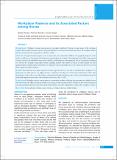Please use this identifier to cite or link to this item:
https://hdl.handle.net/20.500.14356/1637Full metadata record
| DC Field | Value | Language |
|---|---|---|
| dc.contributor.author | Pandey, Manisha | - |
| dc.contributor.author | Bhandari, Tulsi Ram | - |
| dc.contributor.author | Dangal, Ganesh | - |
| dc.date.accessioned | 2023-05-17T06:17:02Z | - |
| dc.date.available | 2023-05-17T06:17:02Z | - |
| dc.date.issued | 2017 | - |
| dc.identifier.citation | PandeyM., BhandariT. R., & DangalG. (2018). Workplace Violence and its Associated Factors among Nurses. Journal of Nepal Health Research Council, 15(3), 235-241. https://doi.org/10.33314/jnhrc.v15i3.1167 | en_US |
| dc.identifier.issn | Print ISSN: 1727-5482; Online ISSN: 1999-6217 | - |
| dc.identifier.uri | http://103.69.126.140:8080/handle/20.500.14356/1637 | - |
| dc.description | Original Article | en_US |
| dc.description.abstract | Abstract Background: Workplace violence among nurses is prevalent worldwide. If nurses become aware of the workplace violence and its risk factors then only they can protect themselves. This study assessed the prevalence of workplace violence and its associated factors among nurses in Pokhara, Nepal. Methods: A hospital-based descriptive cross-sectional study was conducted in Pokhara. The required sample size of the study was 200 nurses. We adopted self-administered questionnaire developed by International Labor Office, International Council of Nurses, World Health Organization (WHO), and Public Services International. Out of 21 hospitals of Pokhara, we selected five hospitals using simple random sampling method. The number of nurses in each hospital was fixed proportionately considering the total number of employed nurses. Individual nurses were selected on the first meet first basis to gain the required number. Results: Two-thirds (64.5%) nurses experienced some type of violence in the last six months at their workplace. The proportion of verbal violence was higher (61.5%) compared to the physical (15.5%) and sexual violence (9%). Most perpetrators of the violence were the relatives of patients and hospital employees. Age of nurses and working stations had statistically significant association with workplace violence (p-value < 0.05). Conclusions: Workplace violence among nurses is a noteworthy problem in Pokhara whereas nearly two-thirds of nurses faced some type of violence in last six months. It is an urge to widen awareness level of nurses on the violence thus, they can take precaution themselves and ask hospital administration and other stakeholders to address the workplace violence. Keywords: Nurses, physical violence; sexual violence; workplace violence; verbal violence. | en_US |
| dc.language.iso | en | en_US |
| dc.relation.ispartofseries | Sep-Dec, 2017;1167 | - |
| dc.subject | Nurses | en_US |
| dc.subject | Physical violence | en_US |
| dc.subject | Sexual violence | en_US |
| dc.subject | Workplace violence | en_US |
| dc.subject | Workplace violence | en_US |
| dc.title | Workplace Violence and its Associated Factors among Nurses | en_US |
| dc.type | Journal Article | en_US |
| local.journal.category | Original Article | - |
| Appears in Collections: | Vol. 15 No. 3 Issue 37 Sep-Dec 2017 | |
Files in This Item:
| File | Description | Size | Format | |
|---|---|---|---|---|
| 1167-Manuscript-3056-1-10-20180101.pdf | Fulltext Download | 279.36 kB | Adobe PDF |  View/Open |
Items in DSpace are protected by copyright, with all rights reserved, unless otherwise indicated.
